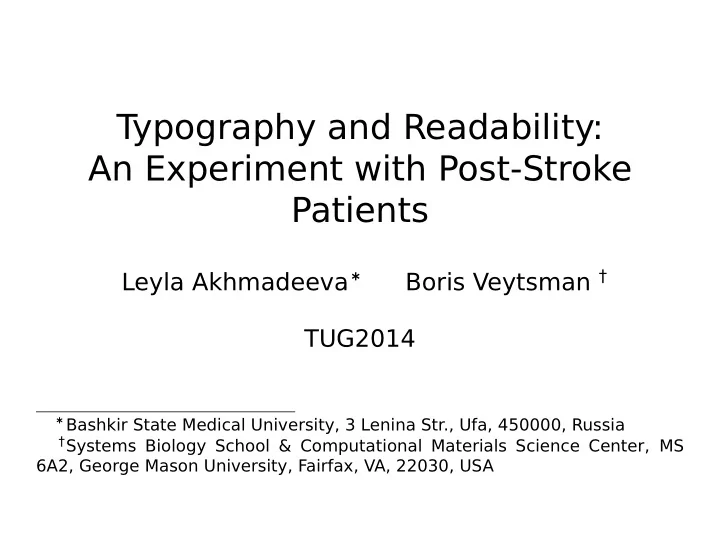

T ypography and Readability: An Experiment with Post-Stroke Patients Leyla Akhmadeeva ∗ Boris Veytsman † TUG2014 ∗ Bashkir State Medical University, 3 Lenina Str., Ufa, 450000, Russia † Systems Biology School & Computational Materials Science Center, MS 6A2, George Mason University, Fairfax, VA, 22030, USA
1. Aims Previous work: despite the lore, the legibility of sans serif and serif are not too different 1 . Reading is a complex process: eyes and brain participate! Do serifs influence recognition of letters? The difference is too small for healthy subjects—what about the post-stroke patients? Will it amplify the differences? 1 Boris Veytsman and Leyla Akhmadeeva. T owards evidence-based typogra- phy: First results. TUGboat , 33(2):156–157, 2012. http://www.tug.org//TUGboat/ tb33-2/tb104veytsman-typo.pdf ; Leyla Akhmadeeva, Ilnar T ukhvatullin, and Boris Veytsman. Do serifs help in comprehension of printed text? An experiment with Cyrillic readers. Vision Research , 65:21–24, 2012. ISSN 0042-6989. doi: 10.1016/j.visres.2012.05.013. URL http://www.sciencedirect.com/science/ article/pii/S0042698912001721
T wo-fold aims: 1. Study how post-stroke patients read texts. 2. Help the patients by giving recommendations to publishers. We compare Paratype Serif and Sans Serif fonts: • Paratype Serif • Paratype Sans
2. Experimental problems 1. Ethics considerations: we cannot ask the patients for something not useful for them! 2. Population problems: we cannot have hundreds of patients. 3. Variance problems: the speed of reading and comprehension varies.
3. Methods 1. The patients are given rehabilitation-related texts (instructions etc) in four parts. 2. Half of the patients receive the parts as Serif → Sans → Serif → Sans, half as Sans → Serif → Sans → Serif 3. We measure time of reading and the number of correct answers. 4. We perform paired comparisons: same patient, different texts.
Selection criteria: 1. Post-stroke patients, 2. Ability to read text, 3. Fluency in Russian language, 4. Absence of dementia, 5. Absence of aphasia Participants selected: N = 19 , including 12 males and 7 females. Average age 54 ± 11 years.
4. An aside: students and patients Words per minute: Words per minute 200 ● ● ● ● 100 50 ● ● Students Patients
Number of correct answers: 10 Number of correct answers 8 6 4 2 Students Patients
5. Results Words per Minute: ● ● Words per minute 150 ● 100 50 ● Serif Sans
Number of correct answers: 9 ● Number of correct answers 8 7 6 5 4 ● Serif Sans
No difference between average numbers. Another approach: paired comparisons: compare serif and sans data for the same patient. Above = y diagonal means Sans > Serif Below = y diagonal means Sans < Serif
Words per minute: 200 150 ● Sans 100 ● ● ● ● ● ● ● ● ● ● ● ● ● ● 50 ● ● ● 0 0 50 100 150 200 Serif
Number of correct answers: 10 ● ● ● ● 8 ● ● ● ● ● ● ● ● ● ● ● 6 Sans ● ● 4 ● 2 0 0 2 4 6 8 10 Serif
6. Conclusions 1. It is more difficult to measure typography influence on the reading by post-stroke patients than by the healthy subjects. 2. The difference between serif and sans serif is very small.
7. Acknowledgements • Lilia Nurtdinova (medical student, Bashkir State Medical University, Ufa, Russia). • Patients • Republic Clinical Hospital, Bashkortostan • TUG
References Boris Veytsman and Leyla Akhmadeeva. T owards evidence-based typography: First results. TUGboat , 33(2): 156–157, 2012. http://www.tug.org//TUGboat/tb33-2/tb104veytsman-typo.pdf . Leyla Akhmadeeva, Ilnar T ukhvatullin, and Boris Veytsman. Do serifs help in comprehension of printed text? An experiment with Cyrillic readers. Vision Research , 65:21–24, 2012. ISSN 0042-6989. doi: 10.1016/j.visres.2012.05.013. URL http: //www.sciencedirect.com/science/article/pii/S0042698912001721 .
Recommend
More recommend